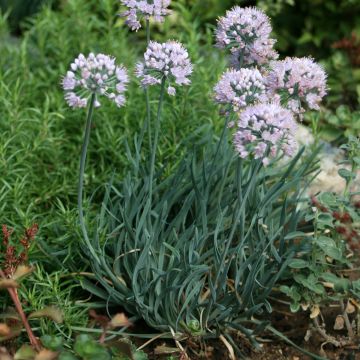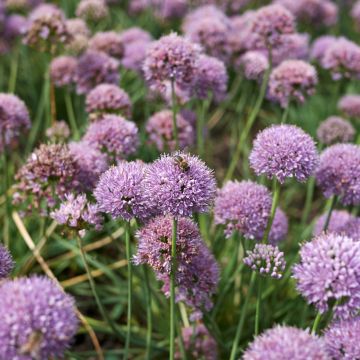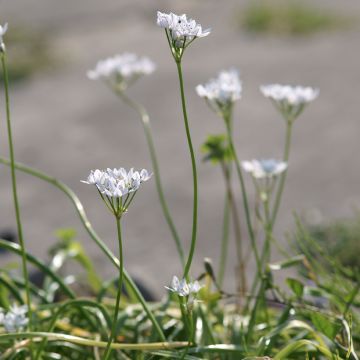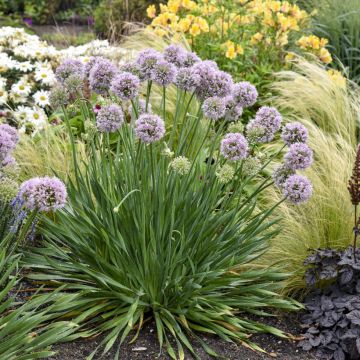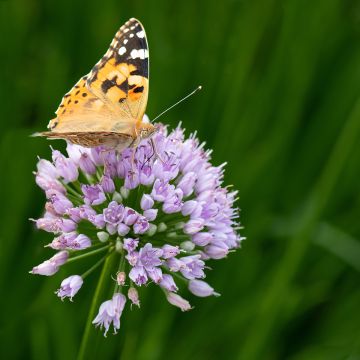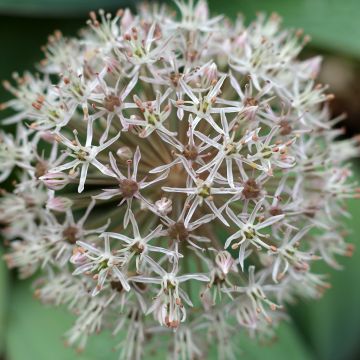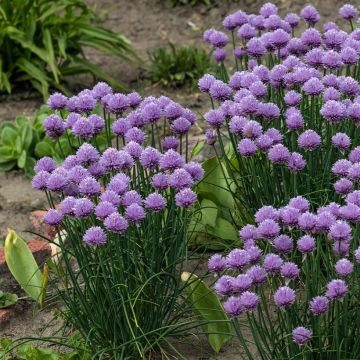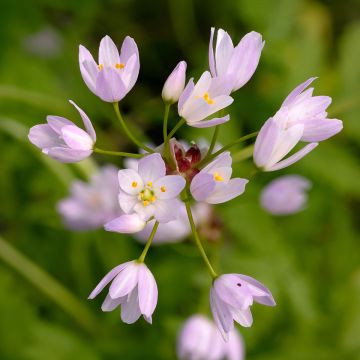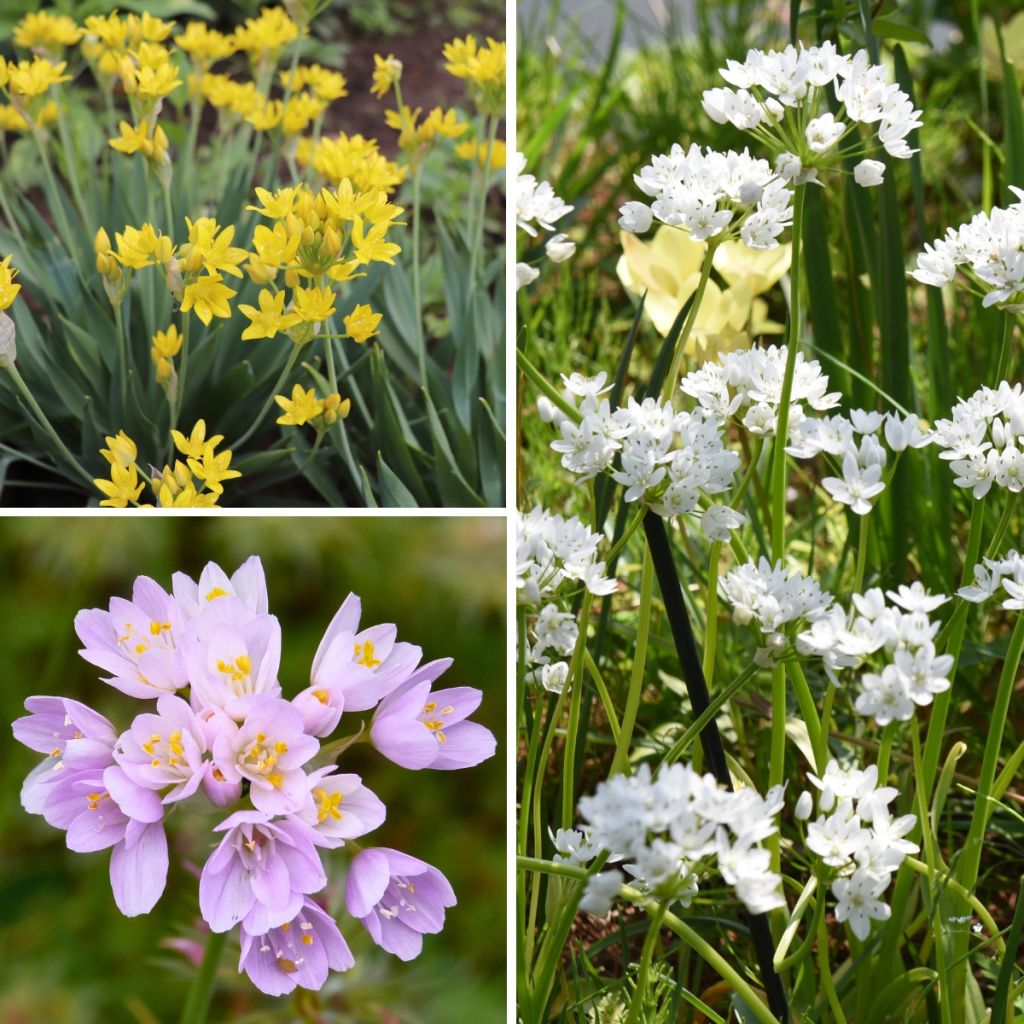

Allium sp
Allium sp
Allium sp
Ornamental Onion, Flowering Garlic
Garlic planted in December, flowering at the end of May and fading by mid-June (which I hoped would last until late June, early July). Unfortunately, they were all the same colour (a very pretty yellow); after flowering, not very interesting, they don't have the beautiful bristly flower heads of larger garlic varieties.
BD, 16/06/2024
This plant carries a 6 months recovery warranty
More information
We guarantee the quality of our plants for a full growing cycle, and will replace at our expense any plant that fails to recover under normal climatic and planting conditions.
From €5.90 for pickup delivery and €6.90 for home delivery
Express home delivery from €8.90.
Does this plant fit my garden?
Set up your Plantfit profile →
Description
This mix of dwarf ornamental garlic brings together different species and varieties of Allium selected for their low height. They all flower in late spring or early summer, in a range of colours. With their sturdy stems, they withstand wind well and are perfect for borders, rockeries, or flowering pots. Ornamental garlic thrives in full sun and requires well-drained soil that does not retain excessive moisture in winter or summer. The colours may vary from one batch to another.
This assortment consists of a mix of dwarf ornamental garlic varieties. All these plants belong to the Amaryllidaceae family. Each bulb develops linear leaves in spring, wide or narrow depending on the plants, with a glaucous colour. Flowering takes place between May and June. Each plant produces one or sometimes two flower stems measuring 20 to 40cm (8 to 16in) in height. At the top of the stems, inflorescences form in spherical umbels, composed of multiple small star-shaped flowers. The flower colour varies depending on the species and varieties. The foliage turns yellow and then disappears with or just after flowering, in summer, when the plant enters dormancy to escape heat and drought. The reserve organ is an underground bulb, covered with a thick tunic.
The flowering of ornamental garlic is colourful and unique. To succeed in their cultivation, it is essential to provide them with light and well-drained soil, which remains moist throughout the growth and flowering period, but drier in winter and summer. They are ideal in rockeries or borders, but can also be grown in pots to enjoy their beautiful flowering on a balcony or patio. Plant them in groups of 5, slipping them between the stones of a rockery, among low ornamental grasses (stipa, carex), or mixed with box balls, garden irises, or perennials such as catmints or salvias, for example.
Report an error about the product description
Plant habit
Flowering
Foliage
Botanical data
Allium
sp
Alliaceae - Liliaceae
Ornamental Onion, Flowering Garlic
Cultivar or hybrid
Other Allium
Planting and care
Dwarf ornamental garlic is easy to grow in any well-drained, light soil and in a very sunny location. Ideally, plant it before the end of October so that it has time to establish itself well. It dreads winter moisture and waterlogged soils, both in winter and in summer. Give it well-drained, rocky or sandy soil, enriched with leaf compost. The soil can even be quite dry in summer and winter. Plant the blubs 10 or 15cm (4 or 6in) deep, spaced 20cm (8in) apart. It is undemanding and will be satisfied with poor soils.
Planting period
Intended location
Care
-
, onOrder confirmed
Reply from on Promesse de fleurs
Haven't found what you were looking for?
Hardiness is the lowest winter temperature a plant can endure without suffering serious damage or even dying. However, hardiness is affected by location (a sheltered area, such as a patio), protection (winter cover) and soil type (hardiness is improved by well-drained soil).

Photo Sharing Terms & Conditions
In order to encourage gardeners to interact and share their experiences, Promesse de fleurs offers various media enabling content to be uploaded onto its Site - in particular via the ‘Photo sharing’ module.
The User agrees to refrain from:
- Posting any content that is illegal, prejudicial, insulting, racist, inciteful to hatred, revisionist, contrary to public decency, that infringes on privacy or on the privacy rights of third parties, in particular the publicity rights of persons and goods, intellectual property rights, or the right to privacy.
- Submitting content on behalf of a third party;
- Impersonate the identity of a third party and/or publish any personal information about a third party;
In general, the User undertakes to refrain from any unethical behaviour.
All Content (in particular text, comments, files, images, photos, videos, creative works, etc.), which may be subject to property or intellectual property rights, image or other private rights, shall remain the property of the User, subject to the limited rights granted by the terms of the licence granted by Promesse de fleurs as stated below. Users are at liberty to publish or not to publish such Content on the Site, notably via the ‘Photo Sharing’ facility, and accept that this Content shall be made public and freely accessible, notably on the Internet.
Users further acknowledge, undertake to have ,and guarantee that they hold all necessary rights and permissions to publish such material on the Site, in particular with regard to the legislation in force pertaining to any privacy, property, intellectual property, image, or contractual rights, or rights of any other nature. By publishing such Content on the Site, Users acknowledge accepting full liability as publishers of the Content within the meaning of the law, and grant Promesse de fleurs, free of charge, an inclusive, worldwide licence for the said Content for the entire duration of its publication, including all reproduction, representation, up/downloading, displaying, performing, transmission, and storage rights.
Users also grant permission for their name to be linked to the Content and accept that this link may not always be made available.
By engaging in posting material, Users consent to their Content becoming automatically accessible on the Internet, in particular on other sites and/or blogs and/or web pages of the Promesse de fleurs site, including in particular social pages and the Promesse de fleurs catalogue.
Users may secure the removal of entrusted content free of charge by issuing a simple request via our contact form.
The flowering period indicated on our website applies to countries and regions located in USDA zone 8 (France, the United Kingdom, Ireland, the Netherlands, etc.)
It will vary according to where you live:
- In zones 9 to 10 (Italy, Spain, Greece, etc.), flowering will occur about 2 to 4 weeks earlier.
- In zones 6 to 7 (Germany, Poland, Slovenia, and lower mountainous regions), flowering will be delayed by 2 to 3 weeks.
- In zone 5 (Central Europe, Scandinavia), blooming will be delayed by 3 to 5 weeks.
In temperate climates, pruning of spring-flowering shrubs (forsythia, spireas, etc.) should be done just after flowering.
Pruning of summer-flowering shrubs (Indian Lilac, Perovskia, etc.) can be done in winter or spring.
In cold regions as well as with frost-sensitive plants, avoid pruning too early when severe frosts may still occur.
The planting period indicated on our website applies to countries and regions located in USDA zone 8 (France, United Kingdom, Ireland, Netherlands).
It will vary according to where you live:
- In Mediterranean zones (Marseille, Madrid, Milan, etc.), autumn and winter are the best planting periods.
- In continental zones (Strasbourg, Munich, Vienna, etc.), delay planting by 2 to 3 weeks in spring and bring it forward by 2 to 4 weeks in autumn.
- In mountainous regions (the Alps, Pyrenees, Carpathians, etc.), it is best to plant in late spring (May-June) or late summer (August-September).
The harvesting period indicated on our website applies to countries and regions in USDA zone 8 (France, England, Ireland, the Netherlands).
In colder areas (Scandinavia, Poland, Austria...) fruit and vegetable harvests are likely to be delayed by 3-4 weeks.
In warmer areas (Italy, Spain, Greece, etc.), harvesting will probably take place earlier, depending on weather conditions.
The sowing periods indicated on our website apply to countries and regions within USDA Zone 8 (France, UK, Ireland, Netherlands).
In colder areas (Scandinavia, Poland, Austria...), delay any outdoor sowing by 3-4 weeks, or sow under glass.
In warmer climes (Italy, Spain, Greece, etc.), bring outdoor sowing forward by a few weeks.

































